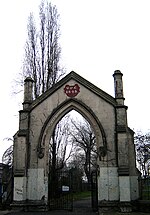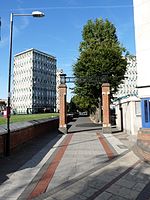Morpeth School

Morpeth School is a comprehensive secondary school situated in Bethnal Green with nearly 1200 pupils. The current headteacher is Jemima Reilly. Morpeth's pupils come from a wide range of ethnic backgrounds; over half are from Bangladeshi backgrounds, while one-third are white British.In 2009 Ofsted highlighted Morpeth as one of twelve outstanding schools serving disadvantaged communities. Morpeth specialises in the Arts and Music, but has also gained some fame in junior table tennis, and offers a wide range of extracurricular activities. Its new Performing Arts building opened in October 2007 and was opened by the British film director and producer (and former Morpeth parent), Danny Boyle in May 2008.
Excerpt from the Wikipedia article Morpeth School (License: CC BY-SA 3.0, Authors, Images).Morpeth School
Portman Place, London Bethnal Green
Geographical coordinates (GPS) Address Website External links Nearby Places Show on map
Geographical coordinates (GPS)
| Latitude | Longitude |
|---|---|
| N 51.5266 ° | E -0.0476 ° |
Address
Morpeth School
Portman Place
E2 0PX London, Bethnal Green
England, United Kingdom
Open on Google Maps










